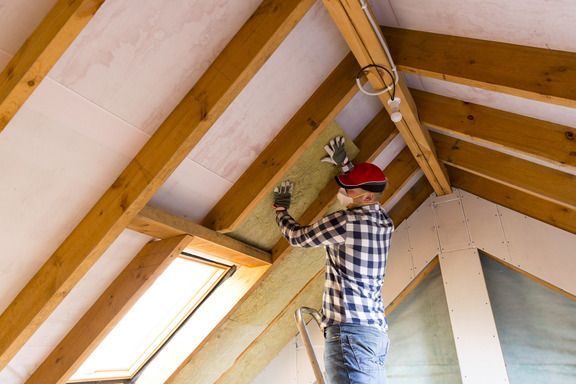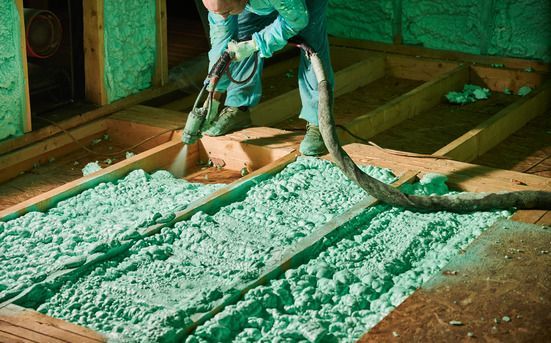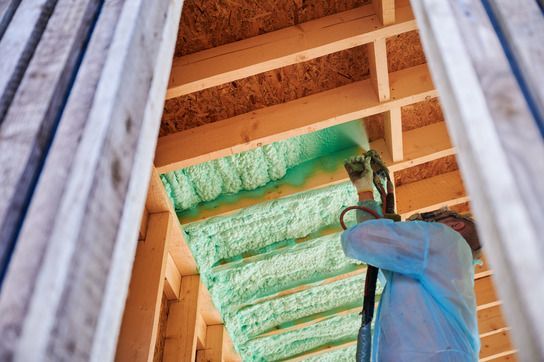Signs Your Attic Insulation Needs an Upgrade
Recognizing the signs that indicate your attic insulation needs an upgrade...

Your attic insulation plays a crucial role in maintaining energy efficiency and comfort within your home. Recognizing the signs that indicate your attic insulation needs an upgrade can help you avoid higher energy bills and uncomfortable living conditions. From visible wear to decreased comfort levels, knowing when to act can make a significant difference.
In Pasadena's unique climate, proper insulation is essential to keep your home comfortable year-round. You'll want to look for certain indicators, such as uneven temperatures in your living areas or increased energy costs, that suggest your insulation may not be performing as it should. Being proactive in assessing your attic can lead to valuable improvements for your home.
Investing in upgraded insulation not only enhances comfort but also promotes better indoor air quality and energy efficiency, which can lead to long-term savings. As you navigate the signs of insufficient attic insulation, keep in mind the benefits that a timely upgrade can offer for both your wallet and your living environment.
Key Takeaways
- Lack of proper insulation can lead to increased energy costs.
- Regular inspection of your attic insulation is essential for comfort.
- Upgrading insulation improves indoor air quality and energy efficiency.
The Importance of Adequate Attic Insulation
Adequate attic insulation is crucial for maintaining a comfortable home environment. It acts as a thermal barrier, reducing heat exchange between your living space and the outdoors. This efficiency is vital for energy conservation.
Proper insulation can prevent heat loss during winter and keep your home cooler in summer. This not only enhances comfort but also reduces your energy bills significantly.
Key Benefits of Adequate Attic Insulation:
- Energy Efficiency: Minimizes reliance on heating and cooling systems.
- Cost Savings: Lowers energy bills by improving thermal performance.
- Increased Home Value: A well-insulated attic can boost your property's market appeal.
You should regularly check your attic insulation, as factors like age and moisture can affect its performance. If your insulation appears compacted, or if you notice temperature fluctuations, it may be time to upgrade.
Consulting with professionals ensures you select the most suitable insulation material. Their expertise can provide insights specific to your home’s needs. By investing in adequate attic insulation, you enhance not only your comfort but also your home’s overall efficiency.
Warning Signs of Insufficient Attic Insulation
Adequate insulation in your attic is crucial for energy efficiency and maintaining a comfortable home. Recognizing the indicators of insufficient insulation can help you avoid higher energy costs and structural damage.
Unusual Temperature Fluctuations
If you notice significant temperature variations between rooms, it may be a sign of poor attic insulation. Drafts and uneven heating affect your comfort and make your heating or cooling systems work harder.
When the attic is not properly insulated, warm air escapes during winter, leading to colder lower levels. In summer, hot air can infiltrate, making rooms uncomfortably warm.
To identify this issue, check different rooms' temperatures against one another. An attic without adequate insulation typically results in an average temperature difference of 5 to 10 degrees. Addressing this promptly can improve your comfort and reduce energy use.
Increased Energy Bills
Unexpected spikes in your monthly energy bills can indicate attic insulation problems. If your heating and cooling systems operate longer to compensate for heat loss or gain, your utility costs will rise.
On average, homes with insufficient attic insulation can experience a 20 to 30% increase in energy expenses. If your bills are consistently higher than normal, it might be time to evaluate your attic's insulation.
Review your energy use over the past year. Any unusual patterns warrant further inspection of your insulation, especially during extreme weather months.
Ice Dams or Icicles in Winter
During winter, ice dams or icicles forming along your roof's edge can signify inadequate insulation in the attic. When heat escapes from the attic, it warms the roof surface, melting snow, which then refreezes at the eaves, causing ice buildup.
These ice formations can lead to significant roof damage and leaks. If you observe icicles that exceed two inches in length, it’s critical to investigate your insulation.
Check for warm areas in your attic during cold months. Proper insulation should prevent heat loss, which reduces the likelihood of ice dams forming.
Water Leaks or Damp Insulation
Moisture buildup or visible water leaks in your attic can indicate problems with insulation. Damp insulation loses its effectiveness and can promote mold and mildew growth.
Water leaks often result from both poor insulation and insufficient sealing of gaps. If you spot damp spots on your ceiling or walls, inspect your attic insulation immediately.
Keep an eye out for insulation that feels wet or has a moldy smell. Replacing damaged insulation and sealing leaks promptly can prevent further complications and protect your home’s integrity.
Impact on Indoor Air Quality and Comfort
Insufficient or deteriorating attic insulation can lead to significant issues with indoor air quality and comfort in your home. These problems manifest primarily through drafts and unexpected temperature fluctuations, as well as the potential attraction of pests.
Drafts and Cold Spots
When attic insulation is inadequate or damaged, you may notice drafts throughout your home. Cold air can seep in from outside, creating uncomfortable living conditions. This not only affects your comfort but can also lead to increased energy bills as your heating system works harder to maintain a consistent temperature.
You can spot cold spots in areas directly beneath the attic. These may feel significantly chillier than the rest of your home. If you experience inconsistencies in temperature control, it’s a sign that your insulation might need to be upgraded. Regular inspections can help identify insulation issues before they escalate.
Pest Infestations
Deteriorating insulation can attract unwanted pests such as rodents and insects. Over time, insulation materials may become nesting grounds for these creatures, compromising both air quality and health. Droppings and debris can infiltrate your home, leading to contamination of the air you breathe.
If you notice an increase in pest activity, consider assessing your attic insulation. Look for signs such as shredded insulation or droppings, indicating pests have taken up residence. Regular checks and upgrades to your insulation can deter infestations and help maintain a safe, comfortable living space.
Inspecting Your Attic Insulation
Regular inspection of your attic insulation is crucial for maintaining energy efficiency and preventing costly damage. You have the option for a professional evaluation or to assess it yourself. Both methods can help identify critical issues that require attention.
Professional Evaluation
Hiring a professional for an attic inspection can ensure a thorough evaluation. Inspectors assess insulation levels, ventilation, and potential structural damage. They can also identify signs of moisture, mold, or pest infestations, which may compromise your insulation's effectiveness.
The evaluation process typically includes:
- Measuring insulation depth: Adequate insulation should be between 13 to 18 inches.
- Checking ventilation: Blocked vents can lead to moisture buildup.
- Examining for pests: Infestations can damage insulation and lead to health hazards.
A professional inspector can provide a detailed report, highlighting areas needing improvement.
Do-It-Yourself Assessment Tips
If you prefer to inspect your attic insulation yourself, here are some practical tips:
- Use a tape measure: Check the depth of your insulation to ensure it meets recommended levels.
- Look for uneven patches: Inspect multiple areas of your attic for any inconsistencies in insulation.
- Check for signs of moisture: Look for water stains or mold growth, which indicate poor ventilation.
Consider using a thermal camera to identify temperature variations in your attic, signaling areas with insufficient insulation. Always wear protective gear like a dust mask and safety glasses while inspecting.
Choosing the Right Insulation for Your Attic
Selecting the appropriate insulation for your attic is crucial for maintaining energy efficiency and comfort in your Pasadena home. Different types of insulation materials and recommended R-values can impact your heating and cooling costs.
Types of Insulation Materials
There are several types of insulation materials you can consider for your attic:
- Fiberglass Batts: Easy to install and cost-effective, fiberglass batts are widely used. They come in pre-cut sections that fit between rafters or joists.
- Blown-In Cellulose: This is an eco-friendly option made from recycled paper products. Cellulose offers excellent coverage in hard-to-reach areas and can fill gaps effectively.
- Spray Foam Insulation: This option expands upon application, sealing gaps and cracks. Spray foam has a higher R-value and provides air sealing, reducing drafts significantly.
- Mineral Wool: Resistant to fire and moisture, mineral wool is a durable choice. It also provides soundproofing benefits, making it suitable for shared walls.
Recommended Insulation Levels for Pasadena, CA
For optimal insulation performance in Pasadena, aim for an R-value between R-30 and R-60. This range is crucial to manage both heating and cooling costs effectively.
Consider the following factors:
- Climate: Pasadena experiences a Mediterranean climate with distinct seasonal temperatures. Adjusting R-values based on weather patterns is vital.
- Building Codes: Always check local regulations regarding insulation levels. Compliance ensures you meet safety standards while enhancing energy efficiency.
- Attic Features: If your attic is frequently utilized, higher insulation levels can help maintain comfort. Evaluate how you use your attic space to determine the best insulation type.
By selecting the right materials and aiming for recommended R-values, you can enhance the comfort and efficiency of your home.
The Upgrade Process
Upgrading your attic insulation involves two critical steps: removal of old insulation and installation of new materials. Each step requires careful attention to ensure your home's energy efficiency is maximized.
Removal of Old Insulation
Before installing new insulation, it’s essential to safely remove any old materials. This may include fiberglass, cellulose, or foam insulation, which can degrade over time.
- Assess the Condition: Inspect the existing insulation for mold, pests, or water damage. These issues can compromise your home’s air quality and insulation effectiveness.
- Safety First: Wear protective gear, including gloves, masks, and goggles, to avoid exposure to harmful particles and irritants.
- Proper Disposal: Dispose of the old insulation according to local regulations. Many areas have designated recycling programs or disposal sites for insulation materials.
This process prepares your attic for a new, energy-efficient installation and ensures that no harmful materials linger.
Installation of New Insulation
Once old insulation is removed, the installation of new insulation can commence. Selecting the right type of insulation is crucial for your home’s needs.
- Choose the Right Material: Options include fiberglass, cellulose, and spray foam. Consider factors like R-value (insulation effectiveness) and moisture resistance.
- Seal Gaps: Before adding new insulation, seal any air leaks around ducts, vents, and wiring. This helps to prevent heat loss and improves overall efficiency.
- Install Evenly: Lay new insulation evenly across the attic floor, ensuring no gaps or compressed areas. The depth and coverage should meet local building codes and your energy efficiency goals.
Following these steps will enhance your attic’s insulation and contribute to long-term energy savings.
Benefits of Upgrading Your Attic Insulation
Upgrading your attic insulation can lead to several important benefits for your home.
1. Enhanced Energy Efficiency
Improved insulation helps maintain a consistent indoor temperature. This efficiency can significantly lower your heating and cooling costs.
2. Reduced Energy Bills
With better insulation, your HVAC system works less. This can lead to noticeably lower energy bills throughout the year.
3. Moisture Control
Upgraded insulation acts as a moisture barrier. This can help reduce the likelihood of mold development in your attic.
4. Noise Reduction
High-quality insulation materials can minimize noise transmission. This creates a quieter living environment by dampening sounds from outside.
5. Increased Home Value
Investing in quality insulation can enhance your property’s value. Potential buyers often appreciate energy-efficient features.
6. Prevention of Frozen Pipes
Proper insulation keeps temperatures stable in the winter. This can help prevent your pipes from freezing, reducing the risk of costly repairs.
7. Improved Indoor Air Quality
Better insulation can reduce drafts and prevent outdoor pollutants from entering. This contributes to a healthier indoor air environment.
Upgrading your attic insulation is a smart move that can provide both immediate and long-term advantages for your home.
Energy Efficiency Incentives and Rebates
Upgrading your attic insulation can not only enhance your home’s comfort but also result in financial benefits. Various incentives and rebates are available that can offset the costs of such improvements.
Types of Incentives:
- Federal Tax Credit: You may qualify for a tax credit of up to $1,200 by making energy-efficient upgrades, including attic insulation.
- State and Local Rebates: Many states and local governments offer rebates through utility companies. These can provide instant discounts or cash-back on qualifying projects.
Eligibility Requirements:
To benefit from these programs, ensure your new insulation meets specific criteria, such as the R-Value recommendations based on the 2009 International Energy Conservation Code (IECC).
How to Claim:
- Research Available Programs: Check with the IRS and local utility providers for current incentives.
- Document Your Expenses: Keep records of all costs related to the insulation upgrade.
- Submit Required Forms: Complete any necessary forms or applications to claim your rebates or tax credits.
Taking advantage of these incentives can make upgrading your attic insulation more affordable. Be sure to explore all your options to maximize your savings.
Maintenance and Longevity of Your Attic Insulation
Maintaining your attic insulation is crucial for its longevity and effectiveness. Regular inspections can help identify any issues early on. Aim for at least one inspection per year.
Signs to Watch For
- Physical Damage: Look for tears or gaps in the insulation.
- Pest Intrusions: Signs of rodents or insects can indicate insulation problems.
- Moisture Issues: Mold or dampness can compromise insulation integrity.
Best Practices for Maintenance
- Control Humidity: Keep humidity levels low to prevent moisture buildup.
- Clear the Space: Ensure that vents and air pathways are unobstructed.
- Schedule Professional Checks: If you notice any signs of damage, consult professionals for advice and potential removal.
Lifespan of Common Insulation Types
| Insulation Type | Typical Lifespan |
|---|---|
| Fiberglass | Up to 50 years |
| Cellulose | 20-30 years |
| Spray Foam | 80 years or more |
By effectively maintaining your attic insulation, you can ensure it serves your home well for many years. Regular care will enhance your home's energy efficiency and comfort.
You might also like
Book a Service Today
We will get back to you as soon as possible
Please try again later
Quick & Reliable
Don’t wait to improve your home’s energy efficiency and comfort. Contact Attic Squad today to schedule your free consultation and take the first step towards a more comfortable, energy-efficient home.
All Rights Reserved | Attic Squad



